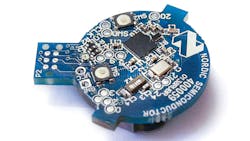Bluetooth Smart is already enabling consumers to communicate with a huge assortment of products and has encouraged developments such as Apple's iOS mobile operating system that lets developers create an abundance of applications that communicate with Bluetooth Smart Accessories.
Industry analysts IHS recently projected that penetration of Bluetooth on all mobile phones—not just smartphones—will hit a high of 96% by 2018. IHS sees mobile phones acting as part of a connectivity hub for a large and varied range of consumer products.
This file type includes high resolution graphics and schematics when applicable.
Smart beacons will play a key role in all this. Apple's iBeacon indoor positioning systems work on Bluetooth Low Energy (BLE), also known as Bluetooth Smart technology. BLE can also be found on Bluetooth 4.0 devices that support dual-mode operation. One potential application for shoppers involves identifying their actual positions in a department store and then “pushing” notifications of special sales to them when available. Such an application could also take payment without customers having to open their purses or pull out their credit cards, similar to Near Field Communications (NFC) systems.
Key Element
The fast development of applications for iOS and Android smartphones will be a key element in all this growth, and ultra-low-power RF specialist Nordic Semiconductor has developed a reference design for Bluetooth Smart beacons based on its nRF51822 multiprotocol Bluetooth Smart and proprietary 2.4-GHz system-on-chip (SoC) device. The Beacon Kit (see photo) will allow designers to develop their own beacon applications using Apple’s iBeacon standards, or create beacons based on their own specifications using Bluetooth Smart.
The kit's firmware is available as source code from Nordic and allows sample beacon scenarios to be created to validate product feasibility. This kit exploits the capability of the nRF51822 SoC to support full Over-The-Air Device Firmware Upgrade (OTA-DFU).
Beacons use advertising packets that include fields to indicate the beacon’s identity. Smartphones use internal received signal strength indication (RSSI) circuitry to estimate distances between handsets and beacons. Whereas beacons only relay advertising to smartphones and not contextual information, the smartphones use the advertising packets to determine the beacon’s identity and decide upon the information and actions relating to that beacon’s location. Permitted actions will vary between phone vendors, depending on imposed limitations but may include audible alerts, vibrations, and enabling of other applications.
The nRF51822 Beacon Kit employs Nordic-developed hardware, firmware, and software and supports both iOS 7 and Android (4.3/4.1) operating systems. As each brand and model of smartphone exhibits different RSSI levels (due to electromagnetic variations stemming from, for example, the individual casing enclosure or antenna employed), the nRF51822 Beacon Kit has a tuning function that allows consistent performance regardless of phone model. It is also a fully functioning demonstrator of Bluetooth Smart beacon technology.
Software Release
Additional software has been announced by Nordic. Its S110 SoftDevice v7.0 is the next major release for its BLE stack, for the nRF51822 BLE and 2.4-GHz proprietary SoC technology, and the nRF51422 ANT and ANT/BLE multiprotocol SoCs.
The S110 SoftDevice v7.0 brings a range of new features including Over-The-Air Device Firmware Upgrade (OTA-DFU), concurrent Peripheral/Broadcaster roles, support for concurrent multiprotocol BLE/2.4-GHz RF proprietary operation, and compliance with the latest version of Bluetooth wireless technology (Bluetooth v4.1), allowing end products using the S110 SoftDevice to be qualified to the Bluetooth standard.
The nRF51 Series SoCs’ flash-based architecture and the S110 SoftDevice’s OTA-DFU feature support flexibility to firmware upgrades not possible with alternative static ROM/OTP-based ULP wireless SoCs.
Now the nRF51822 and nRF51422 SoCs’ stacks and application firmware can be upgraded using the devices’ own wireless link. The OTA-DFU feature allows application and protocol stack upgrades and is not limited to just partial updates and patching.
This file type includes high resolution graphics and schematics when applicable.


